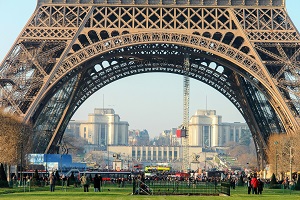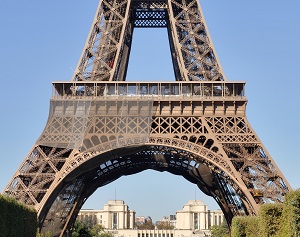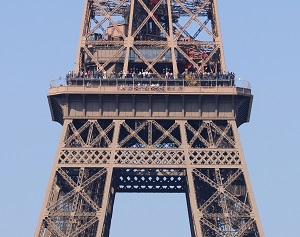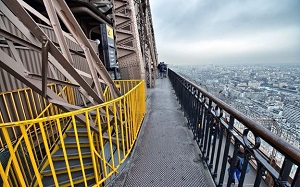Eiffel Tower ticket prices remain the same whether you purchase your tickets online or at a ticket office on-site. However, buying tickets online will save you from lining up at ticket booths on arrival at the Eiffel Tower. Buying your tickets ahead of time will not allow you to skip the elevator line ups.
Skip the line Eiffel Tower tickets are essentially the same as buying tickets in advance through the official Eiffel Tower website. The only line you can skip is the line-up to purchase a ticket. If you visit the Eiffel tower at busy times there will always be line ups for the elevator.
The only way to truly "skip the line" to get into an elevator is to book dinner at one of the Eiffel Tower restaurants. The restaurants have their own elevator access. Alternatively you can book a special sunrise or sunset tour through a number of tour operators. These tours are during off-peak times and see you won't usually need to line up.

The below table includes a brief description of various handpicked Eiffel Tower tickets & skip the line guided tours of the Eiffel Tower. They're based on users reviews, cost, customer experience as well as all the best ways to see the famous Eiffel Tower sight.
We've compared prices from a variety of skip the line Eiffel Tower guided tours & tickets, websites and have handpicked the most affordable Eiffel Tower combination tickets, but utterly enjoyable Eiffel Tower tours & tickets below:

What Is It
What Will Do
What Inclues
Travellers Talk
Is It Right

What Is It
What Will Do
What Inclues
Travellers Talk
Is It Right

What Is It
What Will Do
What Inclues
Travellers Talk
Is It Right

What Is It
What Will Do
What Inclues
Travellers Talk
Is It Right

What Is It
What Will Do
What Inclues
Travellers Talk
Is It Right

What Is It
What Will Do
What Inclues
Travellers Talk
Is It Right

What Is It
What Will Do
What Inclues
Travellers Talk
Is It Right

When France received the honor of hosting the Exposition Universelle, or "World's Fair" of 1889, they were determined to create a centerpiece like no other. The event would be a celebration of the centennial of the French Revolution, an important milestone for the people of France. The organizers launched a competition. Instructions were to "study the possibility of erecting an iron tower of the Champ-de-Mars with a square base, 125 meters across and 300 meters tall". A proposal headed by entrepreneur Gustave Eiffel won.
Engineers Maurice Koechlin and Emile Nougier masterminded the tower's design. They came up with the idea for a "great pylon" made up of four iron lattice girders that would stand in a square and join together at the top, inspired by the Latting Observatory in New York City. The tower would be 300 meters tall, or 1000 feet and like nothing France had ever seen before.
According to Eiffel, the tower would symbolize,
Not only the art of the modern engineer, but also the century of Industry and Science in which we are living, and for which the way was prepared by the great scientific movement of the eighteenth century and by the Revolution of 1789, to which this monument will be built as an expression of France's gratitude" - source Wikipedia
Architect Stephen Sauvestre added important decorative features to the tower. After some debate and misgivings by French officials about the practicality of Eiffel's tower, a contract was signed on the 8th of January 1887. The project broke ground on 28th January 1887.
In January of 1887, a huge team of workers began preparing the foundations for the Eiffel Tower. In July, assembly of the supports began, a task that would take twenty-two months to complete. Metal-workers prepared every piece of the tower, 18,000 pieces in total, in Eiffel's factory, located on the outskirts of Paris. The project's drawing office produced 3,629 exact drawings of the parts needed, accurate to one-tenth of a millimeter. With a project of this scale and intricacy, there was next to no margin for error.
Between 150 and 300 workers used a total of 2.5 million rivets to put the 18,000 pieces of the tower together. By the 31st of March, the Eiffel Tower was almost complete. Eiffel took a group of illustrious guests, accompanied by the press, to the top of the tower to celebrate. Unfortunately, the lift wasn't yet completed and guests had to climb the 1,710-steps to the top.
The Eiffel Tower is synonymous with Paris, France. If you know one thing about Paris, you know that it's home to this iconic structure. But why is the Eiffel Tower so famous?
The Eiffel Tower was the centerpiece of the World's Fair of 1889. This is a significant accolade in itself. But the Eiffel Tower was also created to commemorate the centennial of the French Revolution. A powerful example of architectural and engineering ingenuity, the tower was and remains a symbol of a Free France
The Eiffel Tower's star power was also due to its size. When completed, the Eiffel Tower was the tallest structure in the world. The Chrysler Building in New York snatched this title in 1929. Today, the Eiffel Tower is still the tallest freestanding structure in France.
When architectural plans for the Eiffel Tower were first released, the Parisian public was astounded. Incredibly modern, the tower was the opposite of popular late-19th-century architecture that favored decorative Neo-Renaissance and Neo-Baroque features.
The Eiffel Tower had no real purpose, other than offering the best view of Paris, and was made from iron, a material rarely used in architecture. The lightweight lattice design of the building, allowed engineers to create the Eiffel Tower's then-unrivaled height. The first platform of the tower is 190 feet above the ground. The second is 376 feet high and the third is 900 feet above the ground. There are 108 stories to the tower and you'd have to climb 1,710 steps to reach the top.




When the Eiffel tower first opened in 1889, it had four wooden pavilions on the first floor with restaurants that could seat 500 people. The restaurants were the Trocadero, a restaurants serving Alsation cuisine, a Russian restaurant and Brebant, a chic French eatery. The fourth pavilion was taken up by an Anglo-American bar.
Today, the Eiffel tower has two restaurants, two bars and a number of buffet stalls:
There are shops located on every floor of the Eiffel Tower. Each shop has its own theme and sell items such as fabrics, food and drink, homewares and more.
Gustave Eiffel included an apartment for himself in the original design for the Eiffel Tower. Eiffel entertained important guests in his apartments and conducted various meteorological and scientific experiments. That apartment has been preserved with period decorations and can be visited by the public. Educational tours of the tower reveal more about Eiffel and his work.
The Eiffel Tower is 324 meters (1,063 feet) tall. This includes the antenna at the top. Without the antenna, the tower is exactly 300 meters (984 feet) tall. At the time it was built, the Eiffel Tower was the tallest structure in the world. But not anymore. Here's how the Eiffel Tower matches up to some of the world's other tallest structures:
As the Eiffel Tower is made from iron, it is affected by the temperature of the environment. The heat of the sun has an interesting effect on the tower. On a sunny day, the sun-facing side of the tower can become so hot that expansion causes the top of the tower to move as much as 18 centimeters (7 inches). Expansion caused by the heat of the sun can also make the tower grow by as much as 6 inches.
Windy conditions also affect the Eiffel Tower. The tower can sway by as much as 9 centimeters in very windy conditions but don't worry, the engineers expected this.
The Eiffel Tower is open 365 days per year but opening times vary.
| Dates | By Lift | By Stairs (704 stairs to first floor) |
| 21st of June to 2nd of September | ||
| 21st of June to 2nd of September |
9:00 - 0:45
Last entry midnight (11pm for the top) |
9:00 - 0:45
Last entry midnight |
| Rest of the Year | ||
| Rest of the Year |
9:30 - 23:45
Last entry 11pm. (10.30pm for the top) |
9:30 - 18:30
Last entry 6pm |
As with any tourist attraction that receives visits from thousands of tourists every day, it's best to visit during quiet periods. From November to March, line ups usually last around 30 minutes compared to an average 2 hour wait between June and September.
The busiest time to visit the tower is between 11am and 5pm. If you can, try to visit before 11am or after 8pm for a more relaxed experience. An evening trip to the Eiffel Tower can be particularly magical as you get to see not only the tower but Paris itself lit by a million tiny lights.
It's difficult to get a good photo or selfie with hundreds of other tourists in the frame. Visit during off-peak times to ensure you can carve out your own quiet spot. If you intend to go to the summit, it's a good idea to take the elevator all the way to the top as soon as you arrive. That way, you can stay as long as possible to get the perfect shot. Elevators are glass-walled to get your camera video recorder ready before you get on. Be sure to spend time on the second floor too as this area offers some of the best views. Also consider eating in 58 restaurant as a window seat will give you lots of time to get some great shots of yourself enjoying the view.
You can buy tickets for special sunrise and sunset tours through a number of tour operators. See more here.
Ticket prices for the Eiffel Tower differ depending on what kind of experience you want. Prices changed in January of 2019. These are the new prices.
| Ticket Type | Adult | Youth (12-24 years old) | Child (4-11 years old) | Under 4 |
| Ticket with access lift - Second floor | ||||
| Ticket with access lift - Second floor | 16.30 euros | 8.10 euros | 4.10 euros | Free |
| Ticket with access stairs - Second floor | ||||
| Ticket with access stairs - Second floor | 16.30 euros | 8.10 euros | 4.10 euros | Free |
| Ticket with access lift - The top | ||||
| Ticket with access lift - The top | 25.50 euros | 12.70 euros | 6.40 euros | Free |
| Ticket with access stairs 2nd floor + lift - The top | ||||
| Ticket with access stairs 2nd floor + lift - The top | 19.40 euros | 9.70 euros | 4.90 euros | Free |
Tickets purchased from the Eiffel Tower website may help you skip the line-up at ticket booths but they can only be booked for a specific time and date. As the weather in Paris can change rapidly, especially during winter months, you may not want to do this so you can rearrange your visit if the fog rolls in or it starts to rain.
For stair access only to the second floor, or stair access to second floor and lift access to the top, you must buy your tickets in person. Many people recommend taking the stairs if you're able. That way you can arrive whenever you like. Avoid ground floor elevator line-up and stop whenever you like on the staircase to enjoy the views.
The right ticket for you depends on what you want from your visit. Those travelling with children, people with disabilities and those with little time to spare will be best off pre-booking a second floor ticket. If you have lots of time and are fit and able, climb the stairs to the first or second floor then purchase a ticket for the summit via elevator from the quieter ticket booth there.
Where Exactly is the Eiffel Tower?
The Eiffel Tower's address is as follows: Champ de Mars, 5 Avenue Anatole France, 75007 Paris, France. The tower is located in the 7th arrondissement, in the heart of northern Paris.
How to Get to the Eiffel Tower by Car
There are several car parks located around the Eiffel Tower. However, it is recommended to take public transport if you can to allow disabled drivers to use the spaces available. See a list of nearby parking spaces here.
If you're traveling with children or you or any of your party is disabled, these tips will help you get the most from your visit to the Eiffel Tower.
The Eiffel Tower is located in the 7th arrondissement of Paris and is surrounding by other landmarks and sightseeing areas. Simply grab a Paris tourist map and plan a route!
Here are a few places to visit nearby:
Located in the 16th arondissement of Paris, Trocadero Gardens are considered some of the most beautiful in Paris.
Many cruise operators offer mini-tours up and down the famous River Seine. Cruises are available from one hour to three and some include lunch or dinner and cabaret.
Les invalides is huge complex of museums and monuments located in the 7th arondissement of Paris. The site was originally a hospital and retirement home for war veterans but is now dedicated to France's military history.
Dedicated to famous French sculptor Auguste Rodin, the Musee Rodin is housed in a gorgeous old mansion on the rue de Varenne.
Some of these attractions are free and Paris has much more to offer budget travelers. There are many other free things to do in Paris including a visit to the Notre Dame Cathedral, the Museum of Modern Art and the Puces de St-Ouen Market. Paris is a great city for night owls too. There is always something fun to do in Paris at night.
While tickets for the Eiffel Tower come at one standard cost whether you purchase them online or in person, you can save money by taking a tour, buying multiple attraction tickets from one seller. There are four different Paris Passes available, offering discount on attraction tickets and public transport. However, none of these tickets include a visit to the Eiffel Tower.
You can also combine your visit to the Eiffel Tower with a visit to the Palace of Versailles or a River Seine cruise and save money that way. See this handy guide to the best Eiffel Tower tours and tickets for the best deals on combined attraction tickets.